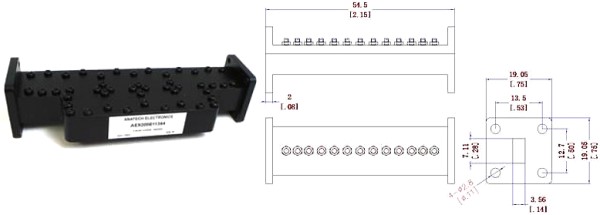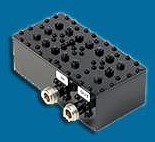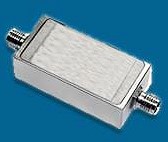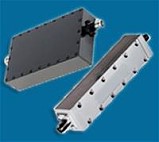
Press Release Archives:
2025 |
2024 |
2023 |
2022 |
2021
2020 |
2019
Content is copyright of company represented. Page format, custom text and
images are RF Cafe copyright - do not distribute. Note: Beginning
March 2025, posting of press releases will cost $100 each for non-advertisers.

Sam Benzacar of Anatech Electronics, an RF and microwave filter company, has published his November
newsletter that features his short op-ed entitled "Do You Think 5G is Challenging?
Meet 6G!," which delves into what can be expected based on current planning. "Like
its predecessor, 6G is more than simply an upgrade in data rates and capacity, as
it will attempt to deliver downstream data rates up to 1 Tbye/s and operate
at frequencies in the so-called sub terahertz region, just below where lightwave
frequencies begin. It will make extensive use of artificial intelligence and machine
learning to enable applications that 5G presumably will not have been addressed
in the next decade." . Also included in the newsletter are a few industry headlines.
A Word from Sam Benzacar
Do You Think 5G is Challenging? Meet 6G!
 By Sam Benzacar By Sam Benzacar
Even though 5G is just now beginning to demonstrate its capabilities, researchers
throughout the world are already concentrating on 6G, which according to most reports
should be deployed around 2030. Like its predecessor, 6G is more than simply an
upgrade in data rates and capacity, as it will attempt to deliver downstream data
rates up to 1 Tbye/s and operate at frequencies in the so-called sub terahertz
region, just below where lightwave frequencies begin. It will make extensive use
of artificial intelligence and machine learning to enable applications that 5G presumably
will not have been addressed in the next decade.
If all this sounds like fantasy, consider that 5G sounded about the same when
it was revealed that frequencies well into the middle millimeter-wave region would
be used for the first time, data rates would be greater than 1 Gb/s, and round-trip
latency would be reduced to a few milliseconds.
Now it appears that most of these promises may be kept, but probably not everywhere,
as the highest data rates will only be achievable at the highest frequencies where
the most bandwidth is available. These are also the regions of the spectrum where
range is very short and attenuation through space can be impeded by almost anything,
from precipitation to foliage, and of course buildings.
There are immense challenges that must be overcome before 6G can become a reality,
from development of semiconductor technologies able to produce measurable power
at sub-terahertz frequencies, to the electronically-steered, phase-array antennas
required to deliver enough gain to overcome the various factors that make communication
extremely difficult in this spectral region.
Will these requirements even be possible? I think they will, because there is
much to gained, well beyond downloading a Netflix in 2 seconds. From extremely precise
location and other sensing applications to anti-jam communications where short-range
is actually desirable, and dozens more.
By 2030, it's likely that huge advances in software-defined hardware, AI, computing
power, and other technologies will have taken place. Networks will evolve from purely
terrestrial wireless to encompassing satellites that fill in the gaps where earth-bound
platforms cannot reach, and a long list of other accomplishments. Time will tell,
but I'm optimistic.
Stay well and Happy Thanksgiving!
 Finland 5G Test Reaches
8 Gb/s Finland 5G Test Reaches
8 Gb/s
Nokia, Elisa, and Qualcomm have achieved the world's fastest 5G speeds on a commercial
network in Finland, delivering speed up to 8 Gb/s. The record was achieved by serving
two Qualcomm 5G millimeter-wave devices connected simultaneously to Elisa's network,
which is powered by Nokia 5G equipment. To complete the record-breaking attempt,
the team used a base station using two Nokia AirScale radios, each using 800 MHz
of millimeter-wave spectrum at 26 GHz. This provided connectivity to two Qualcomm
devices with Snapdragon X55 5G SoCs with each device reaching 4 Gbps peak speeds
from the base station.
 Arecibo Antenna Reaches
the End Arecibo Antenna Reaches
the End
The world-famous Arecibo Observatory in Puerto Rico, known for helping scientists
peer into deep space and listen for distant radio waves, is set to be decommissioned
and demolished after engineers concluded that the facility's structure is at risk
of a collapse. While teams will try to salvage some parts of the observatory, the
decommission will bring an end to the popular 57-year-old telescope. The decision
comes after two major cables failed at the facility in last few months, causing
significant damage to the observatory. The National Science Foundation (NSF), which
oversees Arecibo, determined that the facility's other cables could also soon fail.
If they did, the entire 900-ton suspended platform could come crashing down on Arecibo's
1,000-foot-wide dish. NSF hopes to continue work at the Arecibo Observatory LIDAR
facility and continue operating an offsite facility on the island of Culebra that
collects data on clouds and rainfall
 Dutch Panel Cautions on
5G Radiation Dutch Panel Cautions on
5G Radiation
An advisory panel to the Health Council of the Netherlands is recommending a
“cautious approach” to 5G radiation exposures. The committee is also advising that
the 26 GHz frequency band not be used “for as long as the potential health risks
have not been investigated.” While the panel endorses recently revised guidelines
on the matter it notes that exposure under has the potential to affect health. The
full 800-page report illustrates the concerns and considers that studies on human
health at millimeter-wave frequencies has not been studied as thoroughly as those
currently used by wireless services at 6 GHz and below.
 Tempest Fighter Gets Multifunction
Radar/EW Suite Tempest Fighter Gets Multifunction
Radar/EW Suite
The UK's Tempest sixth-generation fighter aircraft under development for the
Royal Air Force (RAF) will have reconfigurable artificial intelligence and cyber-hardened
communications that allow it to act as a flying command and control center, where
the pilot acts more as an executive officer than a dogfighter. A new radar system
being developed by Leonardo UK called the Multi-Function Radio Frequency System
is claimed to be able to handle 10,000 times more data than existing systems, processing
as much data per second as the entire Internet traffic of a city the size of Edinburgh.
Getting Ready for 5G:
Anatech Electronics introduce New Ka band 30.5 GHz Waveguide Band Pass Filter.
Featuring a center frequency of 30.5 GHz, a bandwidth of 1000 MHz, an Insertion
Loss 1 dB Max, and a Power Handling is 20 watts.

Anatech Electronics Introduces a New Line of Suspended Stripline and
Waveguide Type RF Filters
Check out Our Filter Products



Cavity Band Pass Filters
LC Band Pass Filters Cavity Bandstop/Notch Filter
About Anatech Electronics
Anatech Electronics, Inc. (AEI) specializes in the design and manufacture of
standard and custom RF and microwave filters and other passive components and subsystems
employed in commercial, industrial, and aerospace and applications. Products are
available from an operating frequency range of 10 kHz to 30 GHz and include cavity,
ceramic, crystal, LC, and surface acoustic wave (SAW), as well as power combiners/dividers,
duplexers and diplexers, directional couplers, terminations, attenuators, circulators,
EMI filters, and lightning arrestors. The company's custom products and capabilities
are available at www.anatechelectronics.com.
Contact:
Anatech Electronics, Inc. 70 Outwater Lane Garfield, NJ 07026 (973)
772-4242
sales@anatechelectronics.com
Posted November 23, 2020
|









 By Sam Benzacar
By Sam Benzacar Finland 5G Test Reaches
8 Gb/s
Finland 5G Test Reaches
8 Gb/s Arecibo Antenna Reaches
the End
Arecibo Antenna Reaches
the End Dutch Panel Cautions on
5G Radiation
Dutch Panel Cautions on
5G Radiation Tempest Fighter Gets Multifunction
Radar/EW Suite
Tempest Fighter Gets Multifunction
Radar/EW Suite





